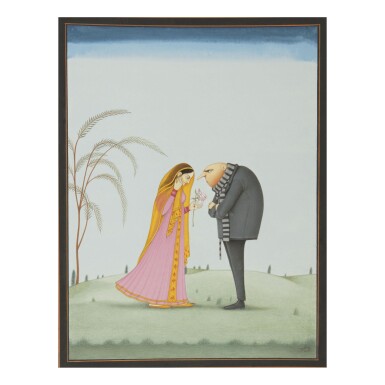Modern & Contemporary South Asian Art
Modern & Contemporary South Asian Art

PROPERTY OF A GENTLEMAN
FARHAT ALI | UNTITLED
Auction Closed
March 16, 05:19 PM GMT
Estimate
800 - 1,200 USD
Lot Details
Description
PROPERTY OF A GENTLEMAN
FARHAT ALI
b. 1988
UNTITLED
Ink and gouache on wasli laid on card
Signed and dated in Urdu lower right
13 ⅜ x 10 ⅜ in. (33.9 x 26.3 cm.)
Painted in 2018
Acquired directly from the artist in 2018- 19
Farhat Ali is a contemporary artist from Badin in Sindh. He started his career as a billboard painter followed by a formal education at the Centre of Excellence in Art and Design at Jamshoro and subsequently the National College of Arts Lahore, from where he graduated in 2015.
Using the quintessentially miniature format from the sub-continent, Ali juxtaposes contrasting characters from different narratives on to one plane. The themes addressed are from history, fiction and contemporary pop and charged with tongue-in-cheek humor. In the current lot, we witness a coy nayika offering a flower to the evil Felonius Gru, the main character from the Despicable Me movies.
“Worked in gouache on wasli the paintings are layered with meaning and technical artistry which prompts inquiry but the witty encounters between Mughal royalty (of miniature art) and contemporary cartoon characters are pure entertainment.” (S. Ali, ‘Art Fiend: Getting There,’ DAWN, 6 September 2015, https://www.dawn.com/news/1204489) Ali shot to fame with his first solo exhibition titled “How did I get here?” (2015).
‘Beyond the immediate element of humor, the improbable encounters and liaisons between the protagonists spark debate on their implausibility. By “disrupting” how we understand something, we are more likely to question its fundamental existence and Ali’s cameos provoke inquiry on several issues. The most obvious inconsistency is the East West variance. His comic approach diffuses the inevitable clash of civilizations between a classical 15th century South Asian era and contemporary Western society. He creates interactive moments between his characters without either losing his or her cultural identity.’ (ibid.)
